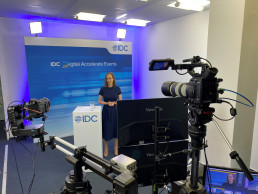At IDC’s European Manufacturing Executive Summit 2021, on November 18, 2021, over 70 “live” attendees from 23 countries discussed the key theme of the event — “The Connected Manufacturing Experience: Transparent, Responsive and Customer Centric”.
An impressive panel of speakers from IDC’s manufacturing CxO community, as well as partners, complemented by insights from our European IDC manufacturing analyst team, explored industry trends and their impact on manufacturing.
Based on the presentations and roundtable discussions from almost 20 sessions, we were able to come up with some key takeaways and highlights from the sessions:
Top 10 Manufacturing Trends in Europe for 2022:
- Keep your hands in the now, but your eyes on the future. This will be key for manufacturing organisations to increase digital resilience because the future will continue to be volatile and uncertain. Use of digital technologies will play a key role to be able to react to unexpected events or incidents or changing market conditions faster and better than before. Balancing the “now”, which is all about maintaining existing IT systems and ensuring that they run safely, securely and reliably, with innovative initiatives to keep an eye on the future will continue to be important for IT decision makers.
- Enabling end-to-end visibility in factories will increasingly also include the ecosystem. To become a resilient, adaptive and sustainable plant, collaboration with ecosystem partners, which includes sharing of collaborative value, cognitive capabilities, data and insights, will be key to leveraging contextual intelligence in decision making.
- Intelligent automation can elevate business operations to gain competitive advantage. A key pillar for a successful implementation of process automation are precise return on investment (ROI) calculations. Increasingly, intelligent automation is moving beyond horizontal functions (e.g., finance and HR) towards core manufacturing operations (e.g., logistics and production).
- Edge computing can help serve a global mission. By bringing together analytics and data to solve major challenges on the shopfloor, in the warehouse or distribution centre, edge computing helps transform not only into a more efficient plant but also to become a more sustainable plant.
- Moving from traditional waterfall models to implementing agile development approaches will be key. Digital transformation (DX) projects are different. They no longer have a fixed end date and are ongoing. One important key to success is to avoid having people applying agile work methods but continuing to think in traditional or waterfall ways; a prerequisite to achieving this is trust.
- The transition to a green business and sustainability has become a key priority. Sustainability must become part of the organisation’s DNA. Setting up measurable characteristics, leveraging digital technology and creating an ecosystem of partners are the cornerstones of the successful transition to a sustainable manufacturing organisation.
- Enabling continuous improvements in the factory requires the right digital solutions. Tools that monitor, measure and correct performance can help to understand hidden issues, root causes and the dynamics between bottlenecks and the prioritised order of bottlenecks, thereby helping to improve operational performance in the factory.
- Ensuring people engagement should never be underestimated with remote work. Remote work impacts how the workforce engages with the company as well as the quality of the job itself. Convergence of culture, the right infrastructure and applications are key pillars of a successful transition to a hybrid work model.
- Ensuring availability, reliability and safety of industrial processes with integrated IT/OT security operations centres (SOCs). Implementing cybersecurity concepts for converged IT/OT systems requires not only specific technology investments but also an alignment of disparate IT and OT specialists with different understanding of and approaches to security. Having one single SOC for IT and OT provides greater efficiency and removes the grey areas of responsibility between IT and OT.
- Building up cyber resilience in converged IT/OT systems will be key to prevent ongoing cyberattacks. Critical manufacturing vulnerabilities are on the rise and ransomware is hitting manufacturing organisations, highlighting that most organisations are implementing cybersecurity tools and measures but are not doing so fast enough. Organisations need to be aware that to achieve cyber resilience in converged IT/OT systems, they need to bridge the IT and OT requirements, engaging the OT team in particular.
Conclusion and Outlook
The IDC European Manufacturing Executive Digital Summit 2021 was very well received by our manufacturing CxO community and our partners as it provided an opportunity to get the latest insights from IDC and its partners, learn from best practices and connect with peers.
Please feel free to access the recordings of our keynote presentations here.
We’re very much looking forward to continuing this dialogue in 2022. We’re already preparing for our next event, which will take place in November 2022, so please stay tuned.
If you’d like to join our manufacturing CxO community or help us create and shape the agenda for next year’s event, please contact Stefanie Naujoks (snaujoks@idc.com).


